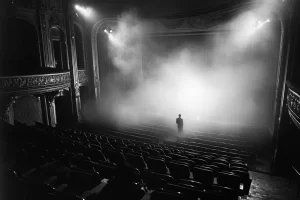
The National Theatre
Posted: 06.27.2024 | Updated: 06.27.2024
Behind a plain windowed façade on Pennsylvania Avenue hides the oldest continuously operating playhouse in the country, The National Theatre. Just a short walk from The White House, it stages the most current crop of popular plays, timeless classics, and renowned Broadway performances.While watching these live shows, you might see a cameo by an actor whose name is nowhere on the Playbill. Though he often appears in the theatre, this actor is not a close friend of Lin-Manuel Miranda or any present-day Broadway darling. He couldn’t be; he died close to a century and a half ago.Despite this minor inconvenience, the spirit seems determined to remain dutifully at the National Theatre. What madness compels this ghost to stay is as dramatic as any play on stage at The National.Who Haunts The National Theatre?
The National Theatre is haunted by the ghost of murdered actor John McCullough. His tragic demise beneath the stage was something pulled out of Shakespeare and has left his soul restless yet happy. He often appears dressed as Hamlet, his first starring role in Washington, and during opening nights of new productions. Take a DC Ghost tour with US Ghost Adventures to hear about it firsthand!The History of The National Theatre
On September 17, 1834, William Wilson Corcoran, an art aficionado, led a meeting of a group of D.C. residents and decided that the underdeveloped city needed a theatre. A year later, on December 7, 1835, The National Theatre opened for the first time with a production of A Man of the World written by the violent 18th-century actor and Irishman Charles Macklin.After its 1835 opening and until 1885, it had endured no less than five fires and had to be at least partially rebuilt each time. Among the original decor was a recreation of the Declaration of Independence and a depiction of George Washington on the stage curtain.The National Theatre has showcased a who’s who of entertainment icons since the beginning. Junius Brutus Booth, father of John Wilkes Booth and his two acting brothers, performed in one of the theatre’s first seasons. Abraham Lincoln’s son, Tad Lincoln, learned of his father’s assassination while attending a play at the National. In 1850, one act, a P.T. Barnum-backed singer named Jenny Lind (also known as “The Swedish Nightingale”), caused riots from Washingtonians trying to get into her two exclusive concert performances. President Millard Filmore, his wife Caroline, his entire cabinet, and all Supreme Court justices at the time even took a break from their duties to attend Lind’s shows.Further into the 20th century, luminaries such as Audrey Hepburn, Robert Redford, Lauren Bacall, Buster Keaton, Debbie Reynolds, Kirk Douglas, Rita Moreno, James Earl Jones, Dame Judi Dench, Sir Ian McKellen, and other classic Hollywood icons appeared on stage in performances at The National Theatre in Washington D.C.The National Theatre has been home to performances of virtually every popular play or musical, including the world premier of West Side Story in 1957, Les Misérables, Fiddler on The Roof, Chicago, and Cats.John McCullough and The National Theatre
Despite his comparative modern obscurity, John McCullough factors into the history and mystique of the National Theatre as much as, if not more than, any of the famous figures named above. His death is the stuff of legend, a harrowing tale that has lasted through the centuries.McCullough, a former carpenter who taught himself to write as a child, entered the theater on a whim and became one of the most iconic Shakespearean actors of Antebellum America. At the height of his career, it was reported that he made $50,000 a year—no small sum for that time. In 1885, he made his way to The National as part of a touring production. It would be his last. McCullough and another actor were at the Tiber Creek below the stage. While washing clothes for a show, McCullough argued with another actor. Depending on the account, the two argued over who was more deserving of either the affections of a beautiful actress in their troupe or the privilege of a leading role. The pair’s arguing turned into a shouting match. Then, with a flash and an explosion, the shouting stopped abruptly.McCullough was shot. He staggered and fell, his hand resting in the Tiber Creek. In an ironic twist of tragedy befitting Shakespeare’s work, the actor died beneath the stage, the very place where some of his life’s brightest, most applauded moments once occurred. Following the shooting, McCullough’s body was unceremoniously buried, late at night, in the dirt-floored cellar under the stage. While this story is captivating, his grave is at the Mount Moriah Cemetery in Philadelphia. He did die in 1885, but at his home in Philadelphia from the crippling effects of Sphyillis. But this doesn’t explain away sightings of his spirit at the National Theatre.The Ghost of John McCullough
Since his death, the spirit of John McCullough has haunted The National Theatre in various forms. The first sighting of McCullough was shortly after his passing on the opening night of a production. His ghost was seen throughout the theatre, assisting in last-minute preparations and checking the props and scenery to ensure the success of the opening night.Curiously, he has been seen dressed in the costumes of his most significant performances. According to some accounts, his spirit is dressed as Hamlet, McCullough’s first role in Washington. In other accounts, McCullough’s ghost donned the attire of his most famous role, Virginius, the doomed Roman centurion.One performer who personally knew McCullough witnessed McCullough’s ghost sitting in the audience in an orchestra chair, calmly watching the performance.Over the remainder of the 1800s and beyond, theatre staff reported seeing McCullough’s ghost drifting throughout The National Theatre: backstage, on staircases, in dressing rooms, and on stage. Most commonly, he is dressed as Hamlet and seated at the prompters' table, a hidden recessed stool and lamp for giving actors their lines.A Washington Post article from 1896 is the first written report of McCullough’s ghost. It includes the following account of another actor, who’d known McCullough in his life, witnessing his ghost. The encounter was described as follows:“His apparition has been observed and recognized repeatedly by his personal friends in the theatrical profession. It was seen so recently as one day the week before last by Frederic Bond, the well-known comedy actor. He was sitting, after the performance, at the prompter’s table . . . when suddenly he heard a slight noise, and looked up . . . After he had sat there a while longer, he felt convinced that he was not alone on the stage . . . he saw a man walk across the stage, and Bond jumped to his feet and cried ‘John McCullough!’Visiting The National Theatre
In 1984, a rusty old gun was discovered underneath the stage where McCullough is said to have been buried. It was given to the Smithsonian, which traced the gun back to the 1850s. While this predates the death of McCullough, murdered or not, by thirty years, it gives possible credence to the slew of spectral sightings reported in the theatre over the years. See a play at The National Theatre and see if you can catch a glimpse of John McCullough for yourself. The playhouse is on Pennsylvania Avenue, on the same street as a certain ivory-hued presidential residence, seems to be a favorite of his even in the afterlife. While you’re in the area, Join us on our DC Ghosts ghost tour. Our tour includes even more of Washington D.C.’s most haunted locations and provides a detailed look into the history and hauntings of the nation’s capital. Read our blog for more information on playhouse phantoms and haunted theatres, and be sure to follow US Ghost Adventures on Facebook, Instagram, and TikTok for even more spooky content! Sources: www.ibdb.com/touring-theatre/national-theatre-586.washington.cbslocal.com/top-lists/best-haunted-locations-in-the-dc-area/https://www.nationaltheatre.org/history/history-of-the-national/ staging.waymarking.com/waymarks/WMDB9N_National_Theatre_Washington_DC.www.washingtonpost.com/archive/lifestyle/1978/10/27/whos-that-pale-guy-in-the-crowd-scene/325ea947-5492-4a64-b1ef-07096a27e9f6/?utm_term=.ee8955dd8fb4.https://thenationaldchistory.org/years-1/ https://www.dib.ie/biography/mccullough-john-edward-a10107 https://thecemeterytraveler.blogspot.com/2014/01/john-mccullough-and-edwin-adams-at.htmlBook A DC Ghosts Tour And See For Yourself
Seekers of power have beaten a path here for hundreds of years. Discover the horrifying truth beneath some of DC’s most famous people and landmarks. In Washington, DC, the ghosts of presidents, assassins, conspirators, and heroes haunt the capital’s historic streets. This ghost tour recounts stories of tragedy, despair, and the very real hauntings experienced today.
Discover the horrifying truth hidden behind the legacies of some of D.C.’s most famous people and landmarks. In Washington D.C., the ghosts of presidents, assassins, heroes, and conspirators haunt the capital’s historic streets.

